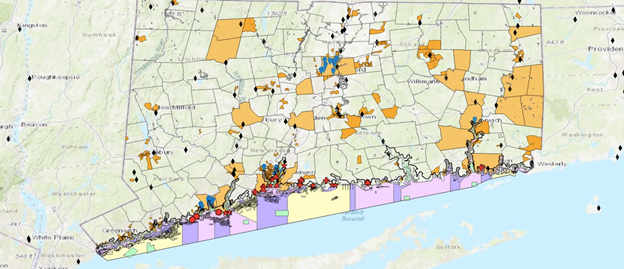Four Yale students from the School of the Environment - Kristina Rodriguez, Marisa Bruno, Alix Pauchet, Tim Ibbotson-Sindelar – have finalized a report which identifies more than 180 watershed improvement projects along Connecticut’s coastline. These students were enrolled in Prof. Brad Gentry’s Nature Based Solution Clinic at Yale.
Their findings were compiled over the course of a semester, as the students worked with Audubon Connecticut’s Director of Policy, Robert LaFrance and the President of Connecticut Association of Conservation Districts, Denise Savageau. The final report will assist the Connecticut Department of Energy and Environmental Protection (DEEP) as it considers sponsoring funding opportunities from Natural Resources Conservation Service (NRCS) of United States Department of Agriculture (USDA). If approved, the funding could be used to implement green and grey infrastructure upgrades along the Connecticut coastline.
The students identified more than 180 projects but narrowed them down to 23 (see red dots on the map below) priority projects based upon selection criteria that they developed.
The focus of these projects was improving salt marsh habitat, shellfish habitat, and water quality. The students also examined methodologies to prioritize projects that help vulnerable communities (Equity Lens) and provide coastal resilience.

After gathering data and compiling already-proposed projects shared by local nonprofits and governmental organizations, the students vetted all 180 projects and broke down the final list of 23 by project type as follows:
Living Shoreline
Chittenden Beach, Grass Island, Long Cove Tidal Marsh, Stony Creek Beach, Sandy Point, New Haven Harbor, Stratford Point Bank, Stratford Russian Beach Bank Protection, Long Wharf, Johnson Creek
Stormwater Retrofit
West Haven High School, Live Oaks Elementary School, Branford High School, Foote Park, Clinton Town Hall, Cox Elementary School
Tidal Flow Restoration
Cove River Tide Gate Relocation and Replacement, Mill River Tidal Flow Restoration, Fort Nathan Hale Tidal Reconnection, Hammock River
Beach Nourishment
Stratford Long Beach, Penfield Beach, Fairfield Beach
The next step in the process is to develop a watershed plan, broken into two sections: One for the eastern and one for the western portion of Long Island Sound. Funding for the planning portion of this project is dependent upon approval by DEEP and NRCS.
Click here to read the full report, including one page project summaries for all 23 sites.






